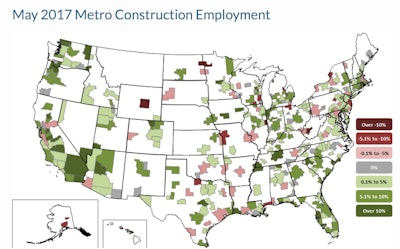
Construction employment increased in 245 out of 358 metro areas between May 2016 and May 2017, declined in 59 and stagnated in 54, according to a new Associated General Contractors of America analysis of federal employment data. Association officials noted that construction employment gains in many parts of the country are occurring even as most firms report having a hard time finding qualified workers to hire.
“Construction employment gains in many parts of the country likely would have been even more robust if it were easier for most firms to find qualified workers,” said Ken Simonson, the association’s chief economist. “As a result of tight labor market conditions, many firms are opting to invest more in training, find ways to become more efficient or use new techniques like off-site prefabrication or robotics to reduce labor needs.”
Riverside-San Bernardino-Ontario, Calif. (16,500 jobs, 18%) added the most construction jobs during the past year, followed by:
- Tampa-St. Petersburg-Clearwater, Fla. (9,100 jobs, 13%)
- Atlanta-Sandy Springs-Roswell, Ga. (7,900 jobs, 7%)
- Las Vegas-Henderson-Paradise, Nev. (7,500 jobs, 14%)
- Los Angeles-Long Beach-Glendale, Calif. (7,000 jobs, 5%)
The largest percentage gains occurred in the Lake Charles, La. metro area (24%, 4,500 jobs), followed by:
- Lewiston, Idaho-Wash. (23%; 300 jobs)
- Detroit-Dearborn-Livonia, Mich. (19%, 4,100 jobs)
- Riverside-San Bernardino-Ontario, Calif. (18%, 16,500 jobs)
The largest job losses from May 2016 to May 2017 were in Houston-The Woodlands-Sugar Land, Texas (-5,300 jobs, -2%), followed by:
- Middlesex-Monmouth-Ocean, N.J. (-3,400 jobs, -9%)
- Pittsburgh, Pa. (-2,900 jobs, -5%)
- Milwaukee-Waukesha-West Allis, Wis. (-2,400 jobs, -8%)
The largest percentage decreases for the year were in:
- Danville, Ill. (-17%, -100 jobs)
- Casper, Wyo. (-15%, -500 jobs)
- Grand Forks, N.D. (-15%, -600 jobs)
- Charleston, W.Va. (-12%, - 900 jobs)
- Bay City, Mich. (-9%, -3,400 jobs)
- Middlesex-Monmouth-Ocean, N.J.
Association officials noted that one of the key reasons for construction workforce shortages is the lack of career and technical education programs available, particularly at the secondary level. They said new legislation to renew the federal Perkins Act, which funds career and technical education programs, would help by giving education officials new flexibility and funding to establishing construction-focused programs. The measure passed in the House last week and association officials urged Senators to approve the measure as well.
“Too many high school students are never given an opportunity to consider careers in construction, despite the fact those jobs pay more than the average non-farm job,” said Stephen E. Sandherr, the association’s chief executive officer. “The Senate should quickly pass new Perkins Act legislation so more students can learn the skills so many employers are looking for today.”



















